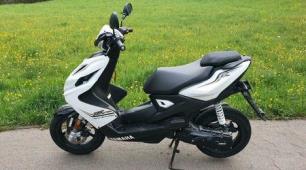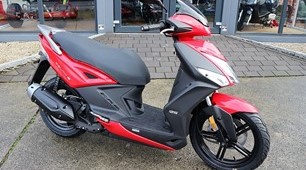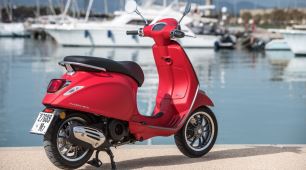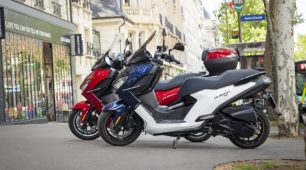 Aprilia SR50R - Service manual > Structure of the Manual, General Rules
Aprilia SR50R - Service manual > Structure of the Manual, General Rules
Structure of the Manual
CONVENTIONS USED IN THE MANUAL
- This manual is divided in sections and subsections, each covering a set of the most significant components. For quick reference, see the summary of sections.
- Unless expressly specified otherwise, assemblies are reassembled by reversing the disassembly procedure.
- The terms "left" and "right" are referred to the motorcycle when viewed from the riding position.
- Motorcycle operation and basic maintenance are covered in the "OWNER'S MANUAL".
In this manual any variants are identified with these symbols:
 engine electronic
injection Purejet
engine electronic
injection Purejet
 engine electronic
injection Ditech
engine electronic
injection Ditech
 carburetor
carburetor
 optional
optional
 catalytic
version
catalytic
version
- all versions
11kW derated version 11 kW
80km speed 80km/h
f.p full-power version
MP national certification
SF European certification (EURO 1 limits)
VERSION:

SAFETY WARNINGS
The following precautionary warnings are used throughout this manual in order to convey the following messages:
 Safety
warning. When you find this symbol on the vehicle or in the manual, be careful
to the potentialrisk of personal injury. Disregarding the instructions
identified by this symbol may compromise thesafety of the user, the motorcycle
and third parties.
Safety
warning. When you find this symbol on the vehicle or in the manual, be careful
to the potentialrisk of personal injury. Disregarding the instructions
identified by this symbol may compromise thesafety of the user, the motorcycle
and third parties.
DANGER Indicates a potential hazard which may result in serious injury or even death.WARNING Indicates a potential hazard which may result in minor personal injury or damage to the vehicle.
CAUTION: The word "CAUTION" in this manual identifies important information or instructions.
General Rules
BASIC SAFETY RULES
CARBON MONOXIDE
When an operation must be performed with the engine running, position the motorcycle outdoors in a well-ventilated area.
Never run the engine in an enclosed place.
Use an exhaust emission extraction system when working indoors.
DANGER Exhaust gases contain carbon monoxide, a poisonous gas which, if inhaled, may cause loss of consciousness or even death.
FUEL
DANGER The fuel used to operate engines is highly flammable and becomes explosive under particular conditions.
Refueling and maintenance operations should be carried out in a well-ventilated area, with the engine off.
Do not smoke when refueling or in the proximity of sources of fuel vapors. Avoid contact with bare flames, sources of sparks and any other source which may ignite fuel or lead to explosion.
DO NOT DISPOSE OF FUEL IN THE ENVIRONMENT.
KEEP AWAY FROM CHILDREN.
HOT COMPONENT PARTS
The engine and exhaust component parts become hot when the engine is running and will stay hot for some time after the engine has been stopped.
Wear insulating gloves before handling these components or allow for the engine and the exhaust system to cool down before proceeding.
USED GEARBOX AND FORK FLUIDS
DANGER Wear latex gloves when servicing.
Prolonged or repeated contact with gear fluid may cause severe skin damage.
Wash your hands thoroughly after handling.
Dispose of it through the nearest waste oil reclamation firm or through the supplier.
Wear latex gloves during servicing.
DO NOT DISPOSE OF FLUID IN THE ENVIRONMENT.
KEEP AWAY FROM CHILDREN.
BRAKE FLUID
WARNING Brake fluid can damage plastic, rubber or painted parts. When servicing the brake system, protect all such parts with a clean cloth.
Always wear safety glasses when servicing the brake system.
Brake fluid is highly irritant. Avoid contact with the eyes.
In case of contact with the eyes, rinse abundantly with cool, clean water and immediately seek medical attention.
KEEP AWAY FROM CHILDREN.
HYDROGEN GAS AND BATTERY ELECTROLYTE
DANGER The battery electrolyte is a toxic, caustic substance containing sulfuric acid and thus able to cause severe burns in case of contact.
Wear close-fitting gloves and protective clothing when handling this fluid.
If any battery fluid gets on your skin, rinse the affected area with abundant fresh water.
Take special care to protect the eyes; even a very small amount of battery fluid can cause blindness. If battery fluid comes in contact with the eyes, flush with abundant water for fifteen minutes and contact an eye specialist immediately.
If battery fluid is swallowed accidentally, drink abundant water or milk. Seek medical attention immediately and keep drinking milk of magnesia or vegetable oil in the meantime.
The battery gives off explosive gases. Keep the battery well away from any sources of ignition, such as flames, sparks, or any heat sources.
Make sure the area is well ventilated when servicing or refilling the battery.
KEEP AWAY FROM CHILDREN.
Battery fluid is corrosive.
Avoid spillage. Take special care not to spill battery fluid on plastic parts.
Ensure that the electrolyte fluid you are using is the suitable type for your battery.
GENERAL PRECAUTIONS AND INFORMATION
Follow these instructions closely when repairing, disassembling or reassembling the motorcycle or its components.
DANGER Using bare flames is strictly forbidden when working on the motorcycle. Before servicing or inspecting the motorcycle: stop the engine and remove the key from the ignition switch; allow the engine and exhaust system to cool down; where possible, lift the motorcycle using adequate equipment placed on firm and level ground. Pay particular attention to any parts of the engine or exhaust system which may still be hot to the touch to avoid burns.
Never put mechanical parts or other vehicle components in your mouth when you have both hands busy. None of the motorcycle components are edible. Some components are harmful to the human body or toxic.
If not expressly indicated otherwise, for the reassembly of the units repeat the disassembly operations in reverse order. Where a procedure is cross-referred to relevant sections in the manual, proceed sensibly to avoid disturbing any parts unless strictly necessary. Do not use polishing pastes on matt paints.
Never use fuel instead of solvent to clean the motorcycle.
Do not clean rubber or plastic parts or the seat with alcohol, gasoline or solvents. Use only water and mild soap.
Always disconnect the battery negative (-) lead before soldering any electrical components.
When two or more persons service the same motorcycle together, special care must be taken to avoid personal injury.
For further details, see (DANGEROUS ELEMENTS).
BEFORE REMOVING ANY COMPONENTS
- Clean off all dirt, mud, and dust and clear any foreign objects from the vehicle before disassembling any components.
- Use the model-specific special tools where specified.
DISASSEMBLING THE COMPONENTS
- Never use pliers or similar tools to slacken and/or tighten nuts and bolts. Always use a suitable wrench.
- Mark the positions of all connections (hoses, wiring, etc.) before disconnecting them. Identify each connection using a distinctive symbol or convention.
- Mark each part clearly to avoid confusion when refitting.
- Thoroughly clean and wash any components you have removed using a detergent with low flash point.
- Mated parts should always be refitted together. These parts will have seated themselves against one another during running as a result of normal wear and tear and should never be mixed up with other similar parts when refitting.
- Certain components are matched-pair parts and should always be replaced as a set.
- Keep away from heat sources.
REASSEMBLING THE COMPONENTS
DANGER Never reuse a circlip or snap ring. These parts must always be replaced once they have been removed.
When fitting a new circlip or snap ring, open the ends just enough to allow fitting to the shaft.
Make a rule to check that a newly fitted circlip or snap ring is fully housed in its groove.
Never use compressed air to clean bearings.
CAUTION All bearings must run freely with no hardness or noise. Replace any bearings that do not meet these requirements.
- Use ORIGINAL aprilia SPARE PARTS only.
- Use the specified lubricants and consumables.
- Where possible, lubricate a part before assembly.
- When tightening nuts and bolts, start with the largest or innermost nut/bolt and observe a cross pattern. Tighten evenly, in subsequent steps, until the specified torque has been achieved.
- Replace any self-locking nuts, gaskets, seals, circlips or snap rings, O-rings, split pins, bolts and screws which have a damaged thread.
- Lubricate bearings abundantly before assembly.
- Make a rule to check that all components you have fitted are correctly in place.
- After repairing the motorcycle and after each service inspection, perform the preliminary checks, and then ride the motorcycle in a private estate area or in a safe area away from traffic.
- Clean all mating surfaces, oil seal edges and gaskets before assembly. Apply a thin layer of lithium grease along the edges of oil seals. Fit oil seals and bearings with the marking or serial number facing outwards (in view).
ELECTRICAL CONNECTORS
Disconnect electrical connectors as follows: failure to follow these instructions can seriously damage the connectors and the wiring.
Press the special safety hooks, where fitted.
WARNING Never separate two connectors by pulling on the wiring.
- Grasp both connectors and pull them in two opposite directions until they become separated.
- Remove dirt, rust, moisture, etc., from inside the connectors with compressed air.
- Ensure that the wires are securely crimped to the terminals inside each connector.
CAUTION: A connector will fit properly only in the matching connector and when inserted in the correct fitting position.
- Reconnect the two connectors. Make sure they are correctly coupled (if fitted with hooks, it should click audibly into place).
TIGHTENING TORQUES
DANGER Do not forget that the tightening torques of all wheel, brake, wheel shaft and other suspension parts are essential to ensuring safe operation of the motorcycle and must be set to the indicated values.
Ensure that these values are always within the specified limits.
Regularly check the tightening torques on all fastenings, and always use a torque wrench when fitting them.
Failure to observe these instructions can result in parts loosening or coming away, thus jamming a wheel or creating other problems which would affect the handling of the motorcycle, potentially resulting in serious injury or death.
See also:
 Aprilia SR50R - Service manual > Dangerous Elements
Aprilia SR50R - Service manual > Dangerous Elements
WARNINGS FUEL DANGER The fuel used to operate engines is highly flammable and becomes explosive under particular conditions.
 BMW R 1250 RT
BMW R 1250 RT Kymco Agility 50
Kymco Agility 50 Piaggio Liberty 50
Piaggio Liberty 50 Yamaha aerox NS50
Yamaha aerox NS50 Aprilia SR50R
Aprilia SR50R Kymco Agility 50
Kymco Agility 50 Vespa Primavera 50
Vespa Primavera 50 Peugeot Speedfight
Peugeot Speedfight